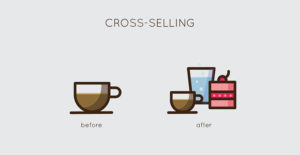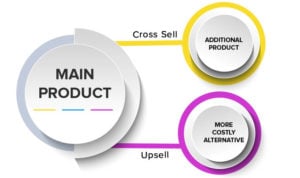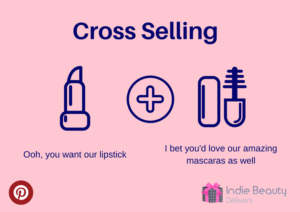Call Sales: +1 (833) 437-3835
Call Sales: +1 (833) 437-3835
Sydney Kida | August 12, 2020 |

Smart marketing experts think not only about how to attract new customers but also about how to increase the value of every single customer. A cross-selling strategy is a perfect option for increasing the value of each customer transaction.

Image Source: https://blog.calltouch.ru/
When a customer buys something, you can suggest that they consider also purchasing related items or complimentary products. This tactic is most successful when done thoughtfully and framed in a way that is helpful. For example, if a customer is purchasing flatware at a home goods store, an effective cross-selling strategy might be the addition of a flatware organizer to accompany the new kitchen goods. The organizer adds value to the customer, and at the same time, adds profit for your store.
People rarely notice cross-selling. When done effectively, customers don’t see it as a marketing strategy. Instead, it should feel like the customer is getting extra service to make their shopping experience easier and unproblematic. Cross-selling shouldn’t be framed as a sales pitch, but rather as a way to show that you care.
Getting new customers to notice you and buy from you is a lot harder than convincing current shoppers to get something additional. After all, the customer is already engaging with you and planning to make a purchase! With the right approach, you can actually improve their experience while growing the size of their transaction.
Some popular examples of cross-selling:
And of course, online shoppers are familiar with the “related items” and “frequently bought together” sections that appear at the bottom of Ecommerce sites. These sections are digital examples of cross-selling.
Here are a few little secrets to help make cross-selling even more profitable.
Remember, subtlety is key! If you constantly remind a customer to buy complementary or related products, they might leave without buying anything at all. For Ecommerce, the best times to cross-sell are on the product page or during checkout.
In the first scenario, a customer is already interested in a specific product. So, they might as well look at what else they need to make it work. For example, a customer may need brushes for their makeup products.
In the second scenario, the checkout process is a great time to remind shoppers of related products. For example, you may suggest downloading VPN services for Android after a customer installs an antivirus app.
One way to avoid customer skepticism with your cross-selling efforts is to promote complementary products that are cheaper than the primary purchase. These products should be small items that don’t require much forethought. Take incidental items in checkout lines at a supermarket, for example. Gum and chocolate bars hardly compare in cost to everything you already have in your shopping cart. You might as well spend a couple more dollars; it will not change the total sum much. So if someone is buying a laptop for $800, it will not make much difference if they include a flash drive for $5 as well.
However, if you are hoping to move complementary items with higher price points, consider offering a sale available to customers who purchase both products. Who doesn’t love a good offer? With this approach, you will be able to sell more expensive complementary products and earn a bigger profit.
Be careful not to offer too many complementary or related products. This may feel counterintuitive. Isn’t it a good idea to give as many options as possible? The reality is, too many choices lead to an overwhelmed customer, which is not good. Shoppers may forget what they planned to buy in the first place and quit the purchase altogether. This situation is especially difficult for indecisive customers. With too many choices, you might get an unsatisfied and irritated customer, even though your intentions were good.

Image Source: makewebbetter.com
If you’re only beginning your journey in cross-selling, don’t worry yourself with finding complements for all of your main products. Besides, you’ll want to experiment first.
Start with a best-seller item. Let's take a lip gloss as an example. Test cross-selling options with a few different product options, such as eyeshadows of the same brand, the lip gloss in another shade, and makeup brushes.
Look at the combination that sells most successfully, and set up a ‘frequently bought together section’ section with your collected data. With a best selling product as your tester, you will collect data much faster and start getting profit from cross-selling as soon as possible.
This advice is a life saver for those whose Ecommerce business is about fashion. The main product can be a dress but can a customer leave without a nice pair of shoes, rings and bracelets, and a brand new bag from this new fashion house? The answer to an experienced cross-seller is no! You can get a customer to buy the whole look. It is really important, though, that you help the shopper visualize how everything will look together. Consider an in-store display, or simply place related products around the main product.
A great way to get feedback is to ask for it! Write your shoppers a follow-up email or call them, and find out whether they liked their purchase. Ask about their experience using the products. The feedback and reviews can offer data-based insights on the value of your combined products, and whether or not they are a strong option for future cross-selling opportunities.
As you see, cross-selling is an effective and efficient marketing strategy with the power to improve customer experience and boost your profits. Moreover, it is not rocket science. With just a few easy tips you can see a big difference in your sales!

Image Source: indiebeautydelivers.com
Are you interested in piloting your cross-selling strategies with an industry-leading point of sale (POS) platform? See how Revel’s cloud-based solution gives you the tools you need to run the business you desire.